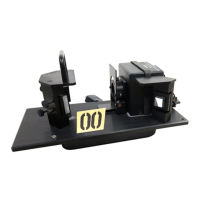AQ-00073-000, Rev. 7 25
The following procedure can be used to measure total transmittance of a sample.
1. Load a diffuse reflectance standard at the sample reflectance port.
2. If you are scanning a liquid sample, load an empty cuvette into the cuvette holder,
and load the entire cuvette holder assembly at the transmittance port. Otherwise,
leave the transmittance port empty.
3. Choose your transmittance sample method from the UV Winlab software or manu-
ally set all instrument parameters as desired.
4. Perform a background correction scan.
5. Load your sample at the transmittance port. If you are measuring a liquid, replace
the empty cuvette with your sample cuvette.
6. Execute a sample scan and save the scan data.
7. The value displayed by the instrument is the sample transmittance.
Note:
When measuring the transmittance of large samples, make sure that the reference or
sample beam is not obscured by any part of the sample, and that the sample compartment lid
closes completely.
The procedure here for total transmittance measurement will produce accurate results for non-
scattering samples. For transmittance samples exhibiting high degree of scattering, the scan
results will be instrument-specific.
You can measure the diffuse transmittance of a test sample using the following procedure:
1. Perform a background correction scan on the accessory with a diffuse reflectance
standard loaded at the sample reflectance port, and an empty cuvette, if used, fitted
in front of the transmittance port.
2. Replace the reflectance standard at the sample reflectance port with a light-trap.
This light trap will capture and exclude from measurement the undiffused portion
of the flux transmitted by the sample.
3. Load the test sample or sample cuvette at the transmittance port and execute a sam-
ple scan.
An approximate regular transmittance of a sample can be determined by measuring the total and
diffuse transmittance, as described above, and subtracting the diffuse component from the total
transmittance.

